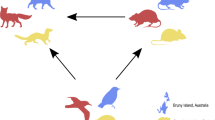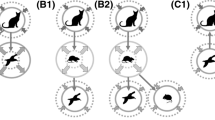Abstract
The question of how to program the removal of two invasive mammals, typically cats and rats, from a marine island without increasing risk to native prey species has received two general answers based on ecological theory: removal of cats must be accompanied by control of their mesopredator prey, and risk is minimized by removing both invaders simultaneously. Nonetheless, a 31-year study showed that in a 82-ha tropical marine bird sanctuary, predation on a native prey, the blue-footed booby, by a native predator, the Atlantic Central American milk snake, apparently diminished after removal of cats then increased 11-fold after the additional removal of black rats. These novel effects are explained in terms of a hypothetical three-link trophic web in which cat removal released rats to increasingly compete with or prey on the snakes that feed on hatchling boobies, and subsequent rat removal released snakes from all remaining predation. The upshot is a disturbing scenario in which approximately 200 milk snakes currently aggregate annually in roughly 1 hectare of booby colony and predate roughly forty percent of the hatchlings. Where the lowest link of an insular trophic web is a native mesopredator that feeds on native prey, the predictions of the classic mesopredator release scenario can be inverted, and removal of invasive mammals may endanger native prey species.




Similar content being viewed by others
Availability of data and materials
Dataset is available as supplementary material.
Code availability
No custom code was used for analyses, all functions in statistical analyses were acknowledged and respective R packages were cited.
References
Ancona S, Sánchez-Colón S, Rodríguez C, Drummond H (2011) El Niño in the warm tropics: local sea temperature predicts breeding parameters and growth of blue-footed boobies. J Anim Ecol 80(4):799–808. https://doi.org/10.1111/j.1365-2656.2011.01821.x
Beggs R, Pierson J, Tulloch AIT, Blanchard W, Westgate MJ, Lindenmayer D (2019) An experimental test of a compensatory nest predation model following lethal control of an overabundant native species. Biol Cons 231(August 2018):122–132. https://doi.org/10.1016/j.biocon.2019.01.003
Bode M, Baker CM, Plein M (2015) Eradicating down the food chain: optimal multispecies eradication schedules for a commonly encountered invaded island ecosystem. J Appl Ecol 52(3):571–579. https://doi.org/10.1111/1365-2664.12429
Bonnaud E, Medina FM, Vidal E, Nogales M, Tershy B, Zavaleta E, Horwath SV (2011) The diet of feral cats on islands: a review and a call for more studies. Biol Invasions 13:581–603. https://doi.org/10.1007/s10530-010-9851-3
Bridgman L, Innes J, Gillies C, Fitzgerald N, Rohan M, King C (2018) Interactions between ship rats and house mice at Pureora Forest Park. N Z J Zool 45(3):238–256. https://doi.org/10.1080/03014223.2018.1464477
Brooke ML, Bonnaud E, Dilley BJ, Flint EN, Holmes ND, Jones HP et al (2018) Seabird population changes following mammal eradications on islands. Anim Conserv 21(1):3–12. https://doi.org/10.1111/acv.12344
Brown WS, Parker WS (1976) A ventral scale clipping system for permanently marking snakes (Reptilia, Serpentes). J Herpetol 10(3):247–249. https://doi.org/10.2307/1562986
Cade BS (2015) Model averaging and muddled multimodel inferences. Ecology 96(9):2370–2382. https://doi.org/10.1890/14-1639.1
Carpenter CC (1952) Comparative ecology of the common garter snake (Thamnophis s. sirtalis), the ribbon snake (Thamnophis s. sauritus), and Butler’s garter snake (Thamnophis butleri) in mixed populations. Ecol Monogr 22(4):235–258. https://doi.org/10.2307/1948469
Cohen EJ (1988) La reducción de la nidada en el bobo café (Sula leucogaster nesiotes, Heller y Snodgrass 1901). Undergraduate thesis, Facultad de Ciencias, Universidad Nacional Autónoma de México
Courchamp F, Chapuis JL, Pascal M (2003) Mammal invaders on islands: impact, control and control impact. Biol Rev Camb Philos Soc 78(3):347–383. https://doi.org/10.1017/S1464793102006061
Courchamp F, Langlais M, Sugihara G (1999) Cats protecting birds: modelling the mesopredator release effect. J Anim Ecol 68(2):282–292
Daltry, JC, James KJ, Otto A, Ross TN (2013) Evidence that eradicating black rats has boosted the recovery of rare reptiles and seabirds on Antiguan islands. Actes du Colloque international Biodiversité insulaire, la flore, la faune et l’homme dans les Petites Antilles, Schoelcher, 2010
DeGregorio BA, Chiavacci SJ, Weatherhead PJ, Willson JD, Benson TJ, Sperry JH (2014) Snake predation on North American bird nests: culprits, patterns and future directions. J Avian Biol 45(4):325–333. https://doi.org/10.1111/jav.00364
Development Core Team R (2020) R: a language and environment for statistical computing. R Foundation for Statistical Computing, Vienna, Austria. http://www.R-project.org/
Doherty TS, Glen AS, Nimmo DG, Ritchie EG, Dickman CR (2016) Invasive predators and global biodiversity loss. Proc Natl Acad Sci 113(40):11261–11265. https://doi.org/10.1073/pnas.1602480113
Drummond H, González E, Osorno JL (1986) Parent-offspring cooperation in the blue-footed boody (Sula nebouxii): social roles in infanticial brood reduction. Behav Ecol Sociobiol 19(5):365–372. https://doi.org/10.1007/BF00295710
Drummond H, Torres R, Krishnan VV (2003) Buffered development: resilience after aggressive subordination in infancy. Am Nat 161(5):794–807. https://doi.org/10.1086/375170
Duffy DC, Capece P (2012) Biology and impacts of Pacific Island invasive species. 7. The domestic cat (Felis catus). Pac Sci 66(2):173–212. https://doi.org/10.2984/66.2.7
Dyer BM (1996) Predation by snakes on seabirds at three South African Islands. S Afr J Mar Sci 17:309–313. https://doi.org/10.2989/025776196784158374
Fitch HS, Fleet RR (1970) Natural history of the milk snake (Lampropeltis triangulum) in Northeastern Kansas. Herpetologica 26(4):387–396
Reed RN, Tucker AD (2012) Determining age, sex and reproductive condition. In: McDiarmid RW, Foster MS, Guyer C, Gibbons JW, Chernoff N (eds) Reptile biodiversity: standard methods for inventory and monitoring. University of California Press, Berkeley
García-Díaz P, Anderson DP, Lurgi M (2019) Evaluating the effects of landscape structure on the recovery of an invasive vertebrate after population control. Landsc Ecol 0123456789:615–626. https://doi.org/10.1007/s10980-019-00796-w
Griffiths R (2011) Targeting multiple species—a more efficient approach to pest eradication. In: Veitch CR, Clout MN, Towns DR (eds) Island invasives: eradication and management. IUCN SSC Invasive Species Specialist Group, Gland, pp 172–176
Grueber CE, Nakagawa S, Laws RJ, Jamieson IG (2011) Multimodel inference in ecology and evolution: challenges and solutions. J Evol Biol 24(4):699–711. https://doi.org/10.1111/j.1420-9101.2010.02210.x
Hu S, Fedorov AV (2019) The extreme El Niño of 2015–2016: the role of westerly and easterly wind bursts, and preconditioning by the failed 2014 event. Clim Dyn 52(12):7339–7357. https://doi.org/10.1007/s00382-017-3531-2
Hu ZZ, Huang B (2009) Interferential impact of ENSO and PDO on dry and wet conditions in the U.S. great plains. J Climate 22(22):6047–6065. https://doi.org/10.1175/2009JCLI2798.1
Jet Propulsion Laboratory (2021) El Niño/La Niña Watch & PDO. Retrived from https://sealevel.jpl.nasa.gov/data/el-nino-la-nina-watch-and-pdo/pacific-decadal-oscillation-pdo/
Jones HP, Holmes ND, Butchart SHM, Tershy BR, Kappes PJ, Corkery I et al (2016) Invasive mammal eradication on islands results in substantial conservation gains. Proc Natl Acad Sci 113(15):4033–4038. https://doi.org/10.1073/pnas.1521179113
Llanes-Cárdenas O, Norzagaray-Campos M, Gaxiola A, González GEG (2020) Regional precipitation teleconnected with PDO-AMO-ENSO in northern Mexico. Theor Appl Climatol 140(1–2):667–681. https://doi.org/10.1007/s00704-019-03003-7
Lenth R, Buerkner P, Herve M, Love J, Riebl H, Singmann H (2021) Estimated marginal means, aka least-squares means version. https://doi.org/10.1080/00031305.1980.10483031
Magnusson A, Skaug H, Nielsen A, Berg C, Kristensen K, Maechler M et al (2020) glmmTMB: generalized linear mixed models using template model builder version. Retrieved from https://github.com/glmmTMB
Mantua N, Hare S (2002) The Pacific decadal oscillation. J Oceanogr 58:35–44
McCreless EE, Huff DD, Croll DA, Tershy BR, Spatz DR, Holmes ND et al (2016) Past and estimated future impact of invasive alien mammals on insular threatened vertebrate populations. Nat Commun 7:1–11. https://doi.org/10.1038/ncomms12488
Medina FM, Bonnaud E, Vidal E, Tershy BR, Zavaleta ES, Josh Donlan C et al (2011) A global review of the impacts of invasive cats on island endangered vertebrates. Glob Change Biol 17(11):3503–3510. https://doi.org/10.1111/j.1365-2486.2011.02464.x
Morrison SA (2011) Trophic considerations in eradicating multiple pests. In: Veitch CR, Clout MN, Towns DR (eds) Island invasives: eradication and management. IUCN, Gland, pp 1–5
Nelson JB (2005) Pelicans, cormorants and their relatives. Oxford University Press, Oxford
Pavia EG (2009) The relationship between Pacific decadal and Southern Oscillations: implications for the climate of northwestern Baja California. Geofisica Internacional 48(4):385–389. https://doi.org/10.22201/igf.00167169p.2009.4.17
Petit-Thouars, Abeli du (1841) Voyage autour du monde sur la fregate La Vénus, pendant les années 1826–1839. París, Gide
Rayner MJ, Hauber ME, Imber MJ, Stamp RK, Clout MN (2007) Spatial heterogeneity of mesopredator release within an oceanic island system. Proc Natl Acad Sci USA 104(52):20862–20865. https://doi.org/10.1073/pnas.0707414105
Rodríguez C, Torres R, Drummond H (2006) Eradicating introduced mammals from a forested tropical island. Biol Conserv. https://doi.org/10.1016/j.biocon.2005.12.005
Rodríguez MC, Drummond H (2000) Exploitation of avian nestlings and lizards by insular milksnakes. Lampropeltis triangulum. J Herpetol 34(1):139. https://doi.org/10.2307/1565250
Samaniego-Herrera A, Aguirre-Munoz A (2011) Rodent eradications on Mexican islands: advances and challenges. Island invasives: eradication and management (IUCN, Gland, Switzerland), pp 350–355
Samaniego Herrera A, Rodríguez Malagón M, Aguirre Muñoz A, González Gómez R, Torres García F, Latofski Robles M, Méndez Sánchez F, Soqui Gómez E, Silva Estudillo N (2009) Erradicación de rata negra en isla Isabel, México. Reporte Técnico. Grupo de Ecología y Conservación de Islas, A.C., Ensenada, B.C., México
Shiels AB, Pitt WC, Sugihara RT, Witmer GW (2014) Biology and impacts of pacific island invasive species. 11. Rattus rattus, the Black Rat (Rodentia: Muridae). Pac Sci 68(2):145–184. https://doi.org/10.2984/68.2.1
Underhill LG, Sherley RB, Dyer BM, Crawford RJM (2009) Interactions between snakes and seabirds on Robben, Schaapen and Meeuw islands, Western Cape province, South Africa. Ostrich 80(2):115–118. https://doi.org/10.2989/OSTRICH.2009.80.2.10.837
Zavaleta ES, Hobbs RJ, Mooney HA (2001) Viewing invasive species removal in a whole-ecosystem context. Trends Ecol Evol 16(8):454–459. https://doi.org/10.1016/S0169-5347(01)02194-2
Zuur AF, Ieno EN, Walker NJ, Saveliev AA, Smith GM (2009) Mixed effects models and extensions in ecology with R. https://doi.org/10.1007/978-0-387-87458-6
Acknowledgements
J.L. Osorno and R. Torres helped monitor the booby population; L. Aguilar, M. Peralta, C. Cortés and N. Sori helped monitor the snake population; M. Salmeron advised on handling and marking snakes; and M. Brooke and H. Greene commented on the manuscript. Logistical support was provided by the Mexican Navy, the fishermen of Nayarit and the staff of the Parque Nacional Isla Isabel. Permissions to work on Isla Isabel were granted by the Secretaría del Medio Ambiente y Recursos Naturales.
Funding
Finance was provided by the Universidad Nacional Autónoma de México (PAPIIT Grants IN211491, IN-200702-3, IN206610-3, IN205313 and IN205819), the Consejo Nacional de Ciencia y Tecnología (Grants 81823, 47599, 34500-V, 4722-N9407 and 104313) and the National Geographic Society (Grant 991416).
Author information
Authors and Affiliations
Contributions
SO: Writing—review & editing, Methodology, Formal analysis, Software, Visualization, Supervision. CR: Conceptualization, Writing—review & editing, Investigation, Data curation, Supervision, Project administration. BM-H: Investigation – data collection, Writing—review & editing. HD: Conceptualization, Methodology, Writing – original draft, Investigation, Funding acquisition, Project administration.
Corresponding author
Ethics declarations
Conflict of interest
The authors have no competing interests to declare.
Consent to participate
Not applicable.
Consent for publication
Not applicable.
Ethics approval
The study was conducted in Parque Nacional Isla Isabel under the permit SGPA/DGVS/012166/17.
Additional information
Publisher's Note
Springer Nature remains neutral with regard to jurisdictional claims in published maps and institutional affiliations.
Supplementary Information
Below is the link to the electronic supplementary material.
Rights and permissions
About this article
Cite this article
Ortega, S., Rodríguez, C., Mendoza-Hernández, B. et al. How removal of cats and rats from an island allowed a native predator to threaten a native bird. Biol Invasions 23, 2749–2761 (2021). https://doi.org/10.1007/s10530-021-02533-4
Received:
Accepted:
Published:
Issue Date:
DOI: https://doi.org/10.1007/s10530-021-02533-4




